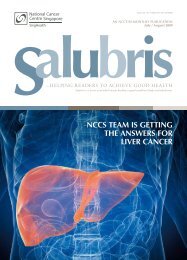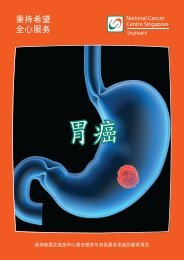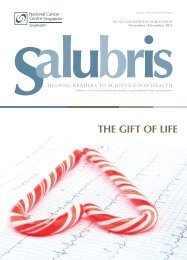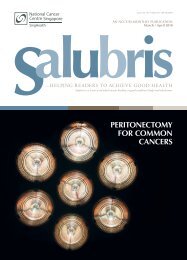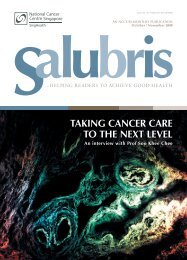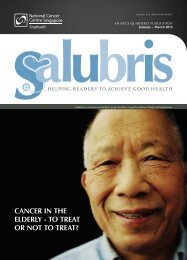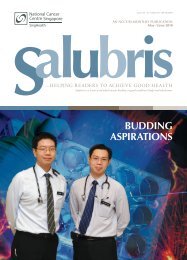Medical Professionals Version - National Cancer Centre Singapore
Medical Professionals Version - National Cancer Centre Singapore
Medical Professionals Version - National Cancer Centre Singapore
Create successful ePaper yourself
Turn your PDF publications into a flip-book with our unique Google optimized e-Paper software.
Issue No. 13 • MICA (P) 149/10/2009<br />
AN NCCS BI-MONTHLY PUBLICATION<br />
November / December 2010<br />
...HELPING READERS TO ACHIEVE GOOD HEALTH<br />
Salubris is a Latin word which means healthy, in good condition (body) and wholesome.<br />
BREAST CANCER<br />
AESTHETICS
PAGE A2<br />
In Focus<br />
SALUBRIS<br />
November / December 2010<br />
PERSPECTIVES ON<br />
LUNG CANCER<br />
NCCS Scientists and Oncologists specialising in the research<br />
and treatment of lung cancer turned out in full force at the<br />
Singhealth – Duke-NUS Scientific Congress to give insightful<br />
updates about the top killer disease. VERONICA LEE reports.<br />
Proposal to ban tobacco products<br />
Perhaps one of the more engaging<br />
presentations that benefited not only the<br />
healthcare professionals but the public as<br />
well was Prof Koong Heng Nung’s proposal<br />
to deny the use of tobacco products for<br />
<strong>Singapore</strong> citizens born in or after the year<br />
2000. The Senior Consultant and Head of<br />
NCCS Department of Surgical Oncology<br />
enumerated the benefits and implications of<br />
his proposal before an attentive audience.<br />
Despite several effective campaigns and<br />
measures that have brought down smoking<br />
prevalence rates from 20% in 1984 to<br />
13.6% in 2007, the number of smokers<br />
between the ages of 12 and 18 has increased significantly. This was mirrored by the<br />
worldwide trend where smokers picked up the habit in their teenage years and this<br />
continued in their adult life.<br />
Prof Koong highlighted the rite of passage that many have come to associate with<br />
smoking, an activity seen to be connected with maturity and adulthood. Many<br />
youngsters are under the false notion that smoking is synonymous with the coming of<br />
age and is an accepted practice for adults.<br />
Although such a proposal may mean limiting one’s freedom, only less<br />
than 11% of the total population surveyed in the <strong>Singapore</strong> Lung<br />
<strong>Cancer</strong> Awareness Study 2007 felt that the proposal impinged on<br />
personal rights and freedom.<br />
Current laws make it difficult for cigarette<br />
vendors who have to do a mental<br />
calculation of the birth rates to ascertain<br />
whether or not the buyer is under-aged.<br />
Given this difficulty, Prof Koong proposed<br />
that a tobacco ban based on a fixed birth<br />
year would be easier to enforce.<br />
Although such a proposal may mean<br />
limiting one’s freedom, only less<br />
than 11% of the total population<br />
surveyed in the <strong>Singapore</strong> Lung <strong>Cancer</strong><br />
Awareness Study 2007 felt that the<br />
proposal impinged on personal rights<br />
and freedom.<br />
The proposal also aimed to minimise<br />
immediate hardship to the tobacco<br />
industry in that smokers who were of the<br />
legal age could still continue smoking<br />
and slowly phase out tobacco use without<br />
a sudden ban which was impractical<br />
given the economic repercussions of an<br />
immediate loss of excise revenues. This<br />
thus fulfils the industry’s assertion about<br />
not attracting new smokers.<br />
‘Proposal To Deny Access<br />
To Tobacco For Those Born<br />
From year 2000’<br />
(A/Prof Koong Heng Nung)
PAGE A3<br />
In Focus<br />
SALUBRIS<br />
November / December 2010<br />
Integrated Signature is valid<br />
in predicting clinical outcome<br />
for early stage lung cancer<br />
Traditionally, treatment for stage 1&2 Lung<br />
<strong>Cancer</strong> is surgery. This has been effective<br />
as the survival rate for patients after<br />
surgery is 40-50%. However, about 30%<br />
of survivors may suffer a relapse and die<br />
within five years. Hence there is the need<br />
to accurately identify patients who might<br />
benefit from adjuvant chemotherapy.<br />
However, Dr Patrick Tan, Principal<br />
Investigator, Division of Cellular and<br />
Molecular Research, who presented<br />
'Genetic Analysis of Lung <strong>Cancer</strong>' shared that the solution may not be as straight<br />
forward as it seemed. Findings from the CALGB 9633 trial had showed that while<br />
there was potential survival benefit for adjuvant chemotherapy in Stage 1B Lung<br />
<strong>Cancer</strong>, an update from the same trial showed no benefits.<br />
Dr Tan suggested that Stage 1B Non Small-Cell Lung <strong>Cancer</strong> (NSCLC) was thus ideal<br />
from which genomic strategies could be further researched, to classify patients with<br />
low and high risk of recurrence, with adjuvant therapy being a treatment option for<br />
high-risk patients.<br />
With one of the biggest challenge of NSCLC<br />
being chromosonal instability that contributes<br />
to inaccuracies in predicting tumour behaviour,<br />
Dr Tan highlighted that a prognostic signature<br />
solely based on gene expression may not<br />
be adequate. Rather, it is the integration of<br />
genomics and gene expression information, or<br />
what he called integrated signature, to derive<br />
a survival model rooted in recurrent CNAs<br />
associated with NSCLC that may be the best bet.<br />
Dr Tan however cautioned against specific<br />
genomic abnormalities which may be present<br />
among Asians and thus render western<br />
benchmarks irrelevant. Studies have shown that<br />
non-tobacco related risk factors exist and neversmokers<br />
constitute a portion of lung cancer<br />
patients, having been exposed to cooking<br />
fumes. Different tissue behaviour was also<br />
discovered between smoker and never-smokers.<br />
‘Genetic Analysis of<br />
Asian Lung <strong>Cancer</strong>s’<br />
(Dr Patrick Tan)<br />
Female Never-Smokers with<br />
East-Asian ethnic background<br />
have better chance of survival<br />
following chemotherapy<br />
Increasingly it has been found that<br />
people who do not smoke also suffer<br />
from lung cancer, suggesting that there<br />
are host differences in susceptibility to<br />
lung cancer and the presence of other<br />
risk factors. About 15% of men and 53%<br />
of women who do not smoke develop<br />
lung cancer, owing to their exposure to<br />
secondhand smoke, asbestos, radon and<br />
related substances, air pollution and<br />
smoke from cooking.<br />
However, the good news is that never-smokers with East Asian ethnicity and<br />
adenocarcinoma make-up are more likely to respond to treatment than their<br />
western counterparts. This was found in the recent clinical development of the<br />
epidermal growth factor receptor (EGFR) tyrosine kinase inhibitors (TKIs),<br />
gefitinib and erlotinib. Mutations in the EGFR kinase domain are more common<br />
and patients with these mutations have increased sensitivity to EGFR TKIs.<br />
Approximately 30-40% of NSCLC patients in<br />
Asia and 10-15% of Caucasians have EGFR<br />
mutation-positive tumours and over 70% of these<br />
patients are women in <strong>Singapore</strong>.<br />
Prof Hui Kam Man, Head of NCCS Division of<br />
Cellular and Molecular Research, presented these<br />
findings of the study, in which gene expression<br />
profiling to measure all the mRNA in the lung<br />
tumor tissues of these patients was carried out. The<br />
team has also identified gene signatures associated<br />
with better treatment responses to chemotherapy<br />
and prolonged survival for female never-smokers<br />
patients with adenocarcinoma of different ethnic<br />
backgrounds. Further molecular evidence was also<br />
presented to demonstrate that Chinese female neversmokers<br />
with adenocarcinoma is not a homogenous<br />
population and the responses to treatment could<br />
also differ within this group of patients.<br />
‘Is East Asian Lung Adenocarcinoma<br />
a Distinct Disease’<br />
(Prof Hui Kam Man)<br />
Continued on page A4.
PAGE A4<br />
In Focus<br />
SALUBRIS<br />
November / December 2010<br />
PERSPECTIVES ON<br />
LUNG CANCER<br />
Continued from page A3.<br />
Genomics techniques is useful<br />
in unraveling drug resistance<br />
About $1.2 million people suffer from<br />
lung cancer annually. Majority present<br />
in the advanced stage and even in<br />
those patients that undergo surgery,<br />
a significant proportion of cases<br />
eventually recur. Advanced stage lung<br />
cancer (Stage 3B and 4) is traditionally<br />
treated with chemotherapy, with<br />
response rates of approximately 20%<br />
with a median survival of six months.<br />
For the past three decades, selection<br />
of chemotherapy regimens for the<br />
treatment of NSCLC has largely been empirical. However, with the advent genomic<br />
technologies, there is now an improved understanding of the disease biology that<br />
has led to classifying lung cancer into molecular subtypes. Importantly, these<br />
subtypes are now amenable to targeted therapeutics, especially in the era of<br />
mechanism-based drug discovery. In the landmark IPASS study, in which NCCS<br />
was one of the participating sites, 1,217 patients were randomly allocated to<br />
either gefitinib (an EGFR tyrosine kinase inhibitor) or carboplatin-paclitaxel. In<br />
approximately two thirds of patients that harboured the EGFR mutation, response<br />
rates were 70%, and the overall median survival 22 months.<br />
Genomics techniques have also been useful in unravelling drug resistance<br />
mechanisms – the common reason for treatment failure. Elucidating these<br />
mechanisms allow the development of rational strategies to overcome them.<br />
A critical aspect is the need for discovering and developing new biological<br />
markers – or biomarkers – that can help in directing these treatments.<br />
However, Dr Daniel Tan, Associate Consultant, Department of <strong>Medical</strong> Oncology,<br />
NCCS warned that while identifying biomarkers that predict for drug response<br />
promise to improve cancer management, it is important that they undergo<br />
sufficient rigor to ensure their validity, reproducibility and repeatability. Indeed<br />
an inaccurate biomarker may be misleading – resulting in unnecessary patient<br />
exposure to ineffective drugs, or conversely patients wrongly deprived of useful<br />
treatments. A new generation of clinical trials is necessary to meet these evolving<br />
concepts of patient selection in targeted therapeutics.<br />
Dr Tan also shared that such translational studies are resource-intense, requiring<br />
multidisciplinary input involving oncologists, basic scientists, radiologists,<br />
pathologists as well as other disciplines. The crucial components of such an<br />
infrastructure are already available in NCCS and the Outram Campus, and the<br />
next few years hold tremendous promise for lung cancer patients.<br />
‘How Genomics has transformed the Therapeutic Landscape<br />
of Non Small Cell Lung <strong>Cancer</strong>’<br />
Dr Daniel Tan<br />
For the past three decades, selection<br />
of chemotherapy regimens for the<br />
treatment of non-small cell lung<br />
cancer (NSCLC) has largely been<br />
empirical. However, with the advent<br />
genomic technologies, there is<br />
now an improved understanding<br />
of the disease biology that has<br />
led to classifying lung cancer into<br />
molecular subtypes.<br />
The SingHealth –<br />
Duke-NUS Scientific<br />
Congress is an annual<br />
event that promotes<br />
the exchange of<br />
medical and healthcare<br />
expertise through<br />
quality fellowship<br />
and educational<br />
activities. Held at the<br />
Suntec International<br />
Convention and<br />
Exhibition <strong>Centre</strong>, it<br />
attracted more than<br />
2,500 healthcare<br />
professionals this year.
IMPROVING COSMETIC<br />
OUTCOMES FOLLOWING<br />
BREAST CANCER SURGERY<br />
PAGE C1<br />
Under The Microscope<br />
SALUBRIS<br />
November / December 2010<br />
It is a sobering fact that <strong>Singapore</strong> has the highest rate of breast cancer in Asia.<br />
It is the commonest cancer among women here, with about 1300 new cases<br />
every year. Management of breast cancer remains challenging and requires a<br />
coordinated, multidisciplinary approach. Despite the continued discovery of<br />
newer and better pharmaceutical agents and improved delivery of radiotherapy,<br />
surgery still remains the cornerstone of breast cancer treatment.<br />
For most women, the diagnosis of breast cancer evokes intense feelings of<br />
fear, anxiety and despair. In addition, the breast is also a powerful emblem<br />
of womanhood. The thought of losing a breast accounts for much of the<br />
reluctance for a patient in undergoing surgery. Following treatment, there is also<br />
considerable long-term psychological impact on self-esteem and body image.<br />
Thankfully, with better understanding of the disease as well as improved surgical<br />
options and techniques, patients can achieve a good cosmetic outcome without<br />
compromising the chances of cure.<br />
By Dr Ong Kong Wee<br />
Consultant<br />
Department of Surgical Oncology<br />
NCCS<br />
Recently, a specialised field of breast cancer surgery termed oncoplastic surgery<br />
is gaining widespread popularity. This evolving area is based on the principles of<br />
surgical oncology as well as plastic and reconstructive surgery, and applies them to<br />
the management of breast cancer patients. It describes a surgical approach encompassing<br />
a wide range of surgical procedures, and not just one particular operation. The aims of<br />
oncoplastic surgery are to achieve wide enough surgical margins to reduce local recurrence<br />
yet optimise cosmetic outcome.<br />
Careful pre-operative planning is the first important step in oncoplastic surgery. In<br />
some cases, a magnetic resonance imaging (MRI) scan of the breasts may be required<br />
to determine the extent of the disease as well as exclude occult contra lateral cancer.<br />
Confirmation of the diagnosis by minimally invasive techniques is essential and allows the<br />
patient to have in-depth discussion with a multidisciplinary team including the surgical<br />
oncologist and plastic surgeon about her surgical options.<br />
Oncoplastic techniques can generally be classified according to whether part of, or the<br />
entire breast, is removed.<br />
When part of the breast is removed, the resulting defect can be filled by either a<br />
displacement or replacement flap. A displacement flap involves mobilising breast tissue<br />
from the same breast to minimise the resultant deformity. In other instances, particularly if<br />
the patient has small breasts, a replacement flap consisting of autologous tissue from other<br />
parts of the body, e.g. back muscles, is fashioned to achieve the desired cosmetic outcome.<br />
Autologous fat transfer has also been tried but is still in an early phase of development. A<br />
key advantage of partial breast surgery using oncoplastic techniques is that larger tumours<br />
can be resected safely compared with standard breast conservation surgery.<br />
Whole breast reconstruction following mastectomy is much more commonly practised<br />
locally. In this procedure, a mastectomy is carried through a small skin incision while<br />
preserving the overlying skin and in selected cases, including the nipple-areolar complex.<br />
The breast mound is then recreated immediately with a myocutaneous flap harvested from<br />
the abdomen or back. Alternatively, a prosthesis may be inserted in lieu of a flap.<br />
Although this procedure is time consuming<br />
and technically demanding, the risks and<br />
possible complications are minimised with<br />
modern surgical approaches.<br />
Current surgical techniques<br />
for breast cancer have<br />
improved by leaps and<br />
bounds, particular over the<br />
last 30 years. Achieving the<br />
twin aims of durable cure as<br />
well as excellent cosmetic<br />
outcome is an established<br />
reality with the techniques<br />
available today.
PAGE C2<br />
Under The Microscope<br />
SALUBRIS<br />
November / December 2010<br />
NCCS TEAM BAGS BEST<br />
POSTER AWARD<br />
FROM EUROPEAN SOCIETY<br />
FOR MEDICAL ONCOLOGISTS<br />
Researchers from the<br />
<strong>National</strong> <strong>Cancer</strong> <strong>Centre</strong><br />
<strong>Singapore</strong> (NCCS) receive<br />
recognition for their work<br />
on Nasopharyngeal <strong>Cancer</strong><br />
from the European Society<br />
For <strong>Medical</strong> Oncologists<br />
(ESMO). VERONICA LEE<br />
finds out more about their<br />
study on vaccines.<br />
Nasopharyngeal cancer (NPC) is<br />
a tumor that is relatively rare<br />
in the west, but common in<br />
<strong>Singapore</strong> and Southeast Asia. Although<br />
the cure rate for patients with early stage<br />
disease is good, patients with advanced<br />
stage disease where the cancer has spread<br />
to other organs, are incurable and have<br />
a poor outlook. Although Chemotherapy<br />
remains the only option for these patients,<br />
it seldom produces durable cancer<br />
control and the disease starts recurring<br />
once chemotherapy is stopped.<br />
The challenges in managing advanced NPC<br />
patients has prompted a team of doctors<br />
and scientists led by Dr Toh Han Chong<br />
and Dr John Chia from the NCCS <strong>Medical</strong><br />
Oncology Department to study novel ways<br />
of targeting the disease, in an attempt to<br />
improve outcomes for their patients.<br />
“NPC is a very interesting<br />
disease, in that it is driven by<br />
the Epstein-Barr virus which<br />
produces cancer causing<br />
proteins that drive cancer<br />
growth” says Dr John Chia, a<br />
Consultant <strong>Medical</strong> Oncologist.<br />
“Because these cancer proteins are also expressed on the surface of<br />
cancer cells, they also make the cancer cells vulnerable to recognition<br />
and killing by the immune system. Our project was to develop a vaccine<br />
that would boost the immune system’s ability to recognise these viral<br />
products on the cancer cells, and then to kill them.”<br />
The team thus began a clinical trial to test a “Dendritic Cell” (DC) vaccine against<br />
NPC in August 2007.<br />
The results of the study, which was carried out on 16 patients, showed that the DC<br />
vaccines that were administered to patients were able to potently activate and train the<br />
patients’ own immune cells to recognise and kill cancer. However, although the results<br />
were promising with no side effects, treatment was not sufficiently potent to cause<br />
eradication of the tumor in most patients.<br />
“The results seemed to indicate that our strategy in targeting the immune system is<br />
feasible and has given us many clues as to how the immune system works in cancer.<br />
But the treatment is not yet ready for prime time.” says Dr John Chia. “Our focus now<br />
is to try to make the vaccine better. We are exploring ways to modify the vaccine and<br />
explore strategies on combining the vaccine with other potent immune targeting cells.<br />
Along this line of research, we have just completed another trial involving the transfer of<br />
large numbers of highly active immune cells derived from patients’ own blood that have<br />
been trained to target and kill nasopharyngeal cancer cells. We are currently analysing<br />
the data and are encouraged by what we have seen so far”.<br />
The study “A Phase 2 study of vaccination with Adenovirus ΔLMP1-LMP2 transduced<br />
dendritic cells in patients with advanced metastatic nasopharyngeal carcinoma” was<br />
a group effort by Dr John Chia, Who-Whong Wang, Dr Marissa Teo, Wai Meng Tai,<br />
Dr Lim Wan Teck, Dr Tan Eng Huat, Dr Leong Swan Swan, Li Sun, Jian Jiun Chen,<br />
Stephen Gottschalk and Dr Toh Han Chong. The team was conferred the Best Poster<br />
(Head and Neck <strong>Cancer</strong>s) by ESMO.
STEREOTACTIC BODY<br />
RADIOTHERAPY<br />
PAGE C3<br />
Spotlight<br />
SALUBRIS<br />
November / December 2010<br />
It is well recognised that radiation therapy plays a<br />
key role in the treatment of a wide range of cancers.<br />
It uses high-energy x-rays to kill cancer cells or keep<br />
them from growing. Often, radiation therapy is used<br />
to cure early stage tumours. In some cases, where the<br />
cancer is diagnosed in the later stages and the tumor<br />
cells have already spread to other parts of the body<br />
such as bones, radiotherapy can still help to control<br />
troublesome symptoms such as pain.<br />
By Dr Anu Thiagarajan<br />
Consultant Radiation Oncologist<br />
NCCS<br />
However, one of the problems of standard radiation therapy has been<br />
collateral damage to surrounding healthy tissues. This occurs because<br />
the area selected for treatment usually includes the whole tumour<br />
plus a varying amount of normal tissue surrounding the tumour. This<br />
normal tissue is treated for two main reasons:<br />
(1) to take into account body movement from breathing and normal<br />
movement of the organs within the body, which can change the<br />
location of a tumour between treatments and<br />
(2) to reduce the likelihood of tumour recurrence from cancer cells<br />
that have spread to the normal tissue next to the tumour (called<br />
microscopic tumour spread).<br />
To minimise damage to neighboring healthy tissues, standard radiotherapy is generally<br />
given in many small doses over several weeks to allow the normal tissues to recover<br />
and regenerate. The total radiation dose administered is also kept comparatively low<br />
in order to protect sensitive normal tissues such as the spinal cord, which, if damaged,<br />
can have devastating consequences for patients, impacting on their daily functioning<br />
ability and quality of life. However, this may sometimes mean that tumours receive<br />
inadequate radiation doses and as a result, the chances of cure may be compromised.<br />
In recent years, the emergence of a new and exciting technology called stereotactic<br />
body radiation therapy (SBRT) has allowed radiation to be delivered with pinpoint<br />
accuracy. Because of the high-precision nature of this treatment, one of the key<br />
requirements to ensure success is mimimal body movement of patients during treatment.<br />
For this reason, during the radiotherapy planning session (also known as simulation), an<br />
immobilisation device is made to help patients remain still during radiation treatment.<br />
While many immobilisation devices are<br />
available, one of the more commonly<br />
used devices is called a BodyFIX bag. It<br />
consists of a bean bag that forms a cushion<br />
under the body, and a plastic sheet that<br />
covers the top of the body. The beanbag<br />
and top sheet are very loose at first, then<br />
tighten as a vacuum removes all the air,<br />
creating a stable and precise body mold.<br />
Once made, this mold is stored and used<br />
every time for treatment. When treatment<br />
is about to begin, a radiation therapist<br />
positions the patient on the treatment<br />
machine in the immobilisation device.<br />
Several images including CT scan images<br />
are taken to ensure that the patient is<br />
positioned accurately and adjustments<br />
are made if needed. The machine that<br />
delivers the radiation then moves around<br />
directing radiation to the body from<br />
several angles. With SBRT, the physician<br />
can even take into account movement of<br />
a tumour based on a patient’s breathing<br />
pattern. Such advancement in accuracy<br />
of radiation treatments means that much<br />
smaller margins of normal tissue are<br />
included in the area of treatment, thereby<br />
allowing much higher doses of radiation<br />
to be delivered, potentially improving the<br />
likelihood of killing the cancer cells of a<br />
tumour and increasing the chances of cure.<br />
Continued on page C4.
PAGE C4<br />
Spotlight<br />
SALUBRIS<br />
November / December 2010<br />
Continued from page C3.<br />
At present, in NCCS, this treatment technique is primarily<br />
offered to patients with early stage lung cancer who<br />
are inoperable owing to poor medical health or those<br />
who refuse surgery. Normally, these patients are offered<br />
a 6-week course of conventional radiation treatment.<br />
However, outcomes have not been ideal with this approach,<br />
with tumour control achieved in only about 30-40% of<br />
patients and more than half of all patients dying from<br />
progressive disease within two years.<br />
Another benefit to the improved accuracy is that treatments can be completed in a short<br />
period of time. Traditional radiation therapy typically requires daily hospital visits, 5 days<br />
a week for five to six weeks. On the other hand, SBRT usually only requires one to five<br />
treatments over one to two weeks. This is of tremendous benefit particularly for patients who<br />
are working full-time, those with young families, those who have long distances to travel to<br />
get to hospital, as well as elderly patients who need assistance to get to and from hospital.<br />
This abbreviated course of radiation reduces the number of trips to the hospital and helps<br />
patients as well as care-givers resume their day-to-day lives as quickly as possible.<br />
As with any type of radiation, side effects may occur with SBRT. Specific<br />
side effects depend on the site being treated and can vary in severity<br />
from patient to patient. These side effects are usually minor, transient<br />
and resolve in the weeks following completion of radiation. Concerns<br />
about worse side effects because of the higher radiation doses used have<br />
fortunately not been seen with multiple trials consistently demonstrating<br />
that treatment-related toxicities were within the acceptable range.<br />
In NCCS, SBRT is delivered using one of two high-end state-of-the-art machines<br />
(Trilogy, or Tomotherapy). Both systems offer CT scanning capabilities, allowing<br />
radiation oncologists to confirm the precise location of tumours with CT scans prior to<br />
each treatment, make necessary adjustments, and administer radiation, all on the same<br />
machine. This gives the treating oncologist greater confidence that radiation is being<br />
delivered exactly as planned. However, the implementation of such complex treatment<br />
does come at a cost. It relies on modern, expensive equipment. It is labour-intensive,<br />
requiring specialised training and coordinated effort between radiation oncologists,<br />
medical physicists, and radiation therapists. Another factor that is key to the success<br />
and safe delivery of this technique is the development and implementation of rigorous<br />
quality assurance procedures. As such, stereotactic body radiation therapy is currently<br />
more expensive than conventional radiation treatment.<br />
At present, in NCCS, this treatment<br />
technique is primarily offered to<br />
patients with early stage lung cancer<br />
who are inoperable owing to poor<br />
medical health or those who refuse<br />
surgery. Normally, these patients<br />
are offered a 6-week course of<br />
conventional radiation treatment.<br />
However, outcomes have not been<br />
ideal with this approach, with tumour<br />
control achieved in only about 30-40%<br />
of patients and more than half of all<br />
patients dying from progressive disease<br />
within two years. With stereotactic<br />
radiation therapy on the other hand,<br />
the preliminary results have been far<br />
superior with long-term tumour control<br />
rates in excess of 70%. In spite of these<br />
promising results, SBRT is still in its<br />
infancy and longer follow-up of patients<br />
is needed to confirm these positive<br />
early results.<br />
Efforts are also currently underway to<br />
expand the usage of SBRT to include<br />
selected patients with spine and liver<br />
tumours. While SBRT is not suitable<br />
for every patient, its potential to be an<br />
effective and convenient alternative to<br />
conventional radiation therapy in the<br />
near future is immense.
PREETI’S LOVE<br />
TRANSCENDS BORDERS<br />
PAGE A5<br />
Community<br />
SALUBRIS<br />
November / December 2010<br />
One concert every six months is what 17-year-old Preeti<br />
Varathan has been doing since 2007. But one particular<br />
concert holds a very special place in the heart of the carnatic<br />
violinist – the concert that took place in New York City this July.<br />
Preeti raised $40,000 for the <strong>National</strong> <strong>Cancer</strong> <strong>Centre</strong> <strong>Singapore</strong><br />
in support of cancer research. CHUA HWEE LENG reports.<br />
A<br />
young and bright lass,who glows<br />
with positive energy, Preeti is no<br />
stranger to cancer. The disease<br />
took her mother away from her life when<br />
she was only six years old. Her late<br />
mother, Madam Hema Devanathan was<br />
only 36 years old.<br />
Despite having witnessed her mother’s<br />
two-year-long struggle with lung cancer,<br />
Preeti did not allow the experience to<br />
wane her. Instead, she was determined<br />
to be stronger each day, refusing to<br />
allow the negative experience to occupy<br />
her thoughts.<br />
Withholding tears, she recounted how<br />
strong her mother was in her fight against<br />
cancer and how the tragic episode had<br />
then affected her.<br />
“Before she was diagnosed with cancer,<br />
I would read to her when I came home<br />
from school. After she was diagnosed<br />
with cancer, she started losing her hair<br />
and put on a lot of weight due to the<br />
treatment she received.<br />
“During later stages, she stayed in her<br />
room most of the time. But in spite of<br />
that, whenever I got home, she would<br />
still let me read to her. It was the kind of<br />
consistency; the little things that touched<br />
me. She wouldn’t allow her illness to<br />
change our routine. I think that was what I<br />
really respected in her,” said Preeti.<br />
Now, Preeti lives with this philosophy,<br />
“I am not the only person to face<br />
tragedy – almost everyone in the world<br />
does as well. But we must not let that<br />
deter us. We have to move on and<br />
pursue what we want for ourselves.”.<br />
Although Preeti was of a young age<br />
then, she understood that her mother<br />
was suffering from pain. However,<br />
Madam Devanathan never showed<br />
her weakness in front of the children.<br />
On her mother’s last gift to her, she<br />
said, “I think strength is what she has<br />
given me.”<br />
After her mother passed away and<br />
was cremated, Preeti and her sister<br />
accompanied their father to the Bay<br />
of Bengal in India to scatter her ashes.<br />
That was when she got exposed to the<br />
carnatic style of playing the violin. To<br />
fill the void in her life, she decided<br />
to go under the tutelage of famous<br />
Carnatic violinist Sri Vittal Ramamurthy.<br />
She learnt well and put her talent to<br />
good use – hosting concerts that raised<br />
funds for healthcare causes. This year<br />
marked her first solo concert outside<br />
India. It was also her first fund-raising<br />
concert for the cancer cause. She<br />
single-handedly booked the concert<br />
hall, printed invitations and posters,<br />
and invited two renowned artistes<br />
– Neyveli R. Narayanan and Samir<br />
Chatterjee – to be her accompanists.<br />
At the concert, which did not come at any<br />
ticket price, Preeti gave a presentation<br />
on cancer research to her audience. They<br />
were strangers to the <strong>National</strong> <strong>Cancer</strong><br />
<strong>Centre</strong> <strong>Singapore</strong> (NCCS). Preeti won their<br />
hearts with her touching presentation and<br />
her performance. The nearly 250-member<br />
audience donated close to $40,000 for<br />
cancer research.<br />
Preeti was not surprised by the warm response<br />
despite the almost 10,000 miles separating<br />
the beneficiary and the donors, as “this is a<br />
universal cause because almost everyone would<br />
know someone who is affected by cancer.”<br />
On why she chose NCCS as the beneficiary,<br />
Preeti said matter-of-factly, “I have been living<br />
here for nearly five years. As an individual<br />
in the community, I think the most important<br />
thing is to help the community around me.”<br />
Preeti, a permanent<br />
resident of <strong>Singapore</strong><br />
and a US Citizen, has<br />
set her sights on going to<br />
the US for further studies<br />
and may well hold<br />
another fund-raising<br />
concert in <strong>Singapore</strong><br />
which will again name<br />
NCCS as the beneficiary.
PAGE A6<br />
People<br />
CHARITY: HER WAY OF LIFE<br />
SALUBRIS<br />
November / December 2010<br />
From Nurse to Administrator and now a<br />
Fund Raiser, that’s the span of job scope that<br />
Flora Yong has embraced since she joined<br />
the <strong>National</strong> <strong>Cancer</strong> <strong>Centre</strong> <strong>Singapore</strong>.<br />
The newly-appointed Manager at the NCCS Foundation,<br />
shares her thoughts with VERONICA LEE.<br />
If you’ve seen Flora Yong all dressed to<br />
the nines don’t be surprised. For her<br />
new role in the NCCS Foundation,<br />
that’s what she needs to do to meet up<br />
with corporate chiefs, business tycoons,<br />
donors and well-wishers. Perhaps some<br />
may still remember her as the woman<br />
with that rich and melodious voice<br />
making the public announcements<br />
twice a day at the <strong>Centre</strong> during the<br />
outbreak of the H1N1 flu some two years<br />
ago. Certainly with her demure and<br />
confident personality, good vocal chords<br />
and a sound knowledge about cancer,<br />
Flora is set to open more doors for<br />
the Foundation.<br />
With her new appointment as<br />
Manager of Community Partnership<br />
and Fundraising, she has a mammoth<br />
task ahead of her. Together with the<br />
Foundation’s Director Dr Tan Hiang<br />
Khoon, she will be building a new<br />
team for the fund-raising arm of NCCS.<br />
No longer is she worried about patient<br />
clinical issues. Instead she has to set<br />
her sights on how to help raise the<br />
millions that are required to support the<br />
many cutting-edge research projects<br />
undertaken by the clinicians and<br />
researchers at the NCCS laboratories.<br />
While she may not have worked in the<br />
laboratories, Flora is certainly familiar<br />
with medicines and their roles in saving<br />
lives. She was trained as a Staff Nurse<br />
before rising to Nurse Manager in<br />
the <strong>Singapore</strong> General Hospital. She<br />
joined NCCS in May, 1999 and started<br />
the <strong>Cancer</strong> Education and Information<br />
Service (CEIS), whose role was to<br />
provide public education on cancer and<br />
also to answer public inquiries on the<br />
<strong>Cancer</strong> Helpline.<br />
Under her watch, CEIS introduced<br />
many cancer awareness programmes for<br />
patients and the public and produced<br />
the inaugural issue of a newsletter that<br />
has an audience of 22,000 readers. The<br />
<strong>Cancer</strong> Helpline also took off successfully<br />
since it was launched in September 2000<br />
attracting more than 90 calls on the first<br />
day of its operations.<br />
The helpline now gets an average of 350<br />
contacts per month. Here she learnt to<br />
understand the demands and anxieties<br />
of the patients, and despite the heavy<br />
workload she had the satisfaction of being<br />
able to offer a listening ear and knowing<br />
that a few helpful words had calmed the<br />
nerves of the callers.<br />
Indeed, the love of sharing and offering<br />
her time for charitable causes was<br />
imbued in her since her growing up years<br />
in Batu Pahat, Johor. She would take part<br />
in fund-raising activities like Flag Day or<br />
sell cookies, cakes and candies baked by<br />
her mother, to support charitable causes.<br />
During the Christmas season, she would<br />
join a youth group of carolers to make<br />
their rounds to raise funds for the needy.<br />
As a Girl Guide in school, she visited<br />
old folks’ homes to help clean up their<br />
premises and bring cheer to them.
PAGE A7<br />
People<br />
SALUBRIS<br />
November / December 2010<br />
“It’s not only about giving money. It’s<br />
also about giving kindness in words<br />
and in deeds and that helps a lot<br />
especially to those who are faced<br />
with life-threatening illnesses. They<br />
need kind words and hands to hold<br />
on to for strength as they go through<br />
their arduous cancer journey.”<br />
Flora Yong<br />
Flora (second from left) with the former<br />
President Wee Kim Wee.<br />
Looking back at her childhood, she<br />
surmised that her love for charity just<br />
blossomed from there. “Helping did not<br />
mean much to me as a child. I just knew<br />
I had to be a good little girl and help<br />
whenever it was needed. Giving help<br />
holds a much deeper meaning to me<br />
now as an adult.<br />
“It’s not only about giving money. It’s also<br />
about giving kindness in words and in<br />
deeds and that helps a lot especially to<br />
those who are faced with life-threatening<br />
illnesses. They need kind words and<br />
hands to hold on to for strength as they go<br />
through their arduous cancer journey,” said<br />
Flora who is someone who walks the talk.<br />
She has offered her paintings for sale at a<br />
recent art exhibition in a bid to raise funds<br />
for patient support programmes. With her<br />
new role at NCCS Foundation, she feels she<br />
has come full circle and is all set for the<br />
greatest challenge – to raise funds for cancer<br />
research. Barely weeks into her job, she was<br />
thrown “into the deep end” and was roped<br />
into the working committee for the Run for<br />
Hope which was held on 21 Nov. The Run<br />
drew a record 7,000 participants and was<br />
organised jointly with the Four Seasons<br />
Hotel and the Regent Hotel.<br />
She tapped on her network and worked<br />
with Borders Bookstore for convenience<br />
of registering prospective participants<br />
at the bookstore in Orchard Road. In<br />
December, she arranged for teams of<br />
volunteers to do gift wrapping at the<br />
bookstore. In return, NCCS Foundation<br />
will sell the gift cards to raise money for<br />
cancer research.<br />
When asked why she felt charity was<br />
so important to her, she replied, “I have<br />
received many acts of kindness in my<br />
life. Although they were not monetary in<br />
value, each of them taught me valuable<br />
lessons on being generous and kind to<br />
others. So I want to keep this flame alive<br />
and pass it on to others. Everything comes<br />
full circle, I believe what I give now will<br />
be returned at a time when I least expect<br />
it and when I most need it.”<br />
Although she was at first apprehensive about<br />
her role in fund raising, Flora decided to<br />
take on the challenge as she believes she<br />
can help the Foundation to move on to its<br />
next phase given her background knowledge<br />
of NCCS. She sees it as an opportunity to<br />
push boundaries and see how far she can<br />
go. Speaking before audiences is something<br />
she does with confidence, having been<br />
the founding President of the SingHealth<br />
Toastmasters Club in 2004.<br />
But it is still early days as Flora confesses.<br />
The team is new and her immediate task<br />
is to help the team members learn the<br />
ropes. Believing that each of her team<br />
members have their own talents, she<br />
hopes they will contribute effectively and<br />
work cohesively towards the long term<br />
goals of raising funds and maintaining<br />
lasting relationships with donors.
PAGE A8<br />
NCC Foundation<br />
SALUBRIS<br />
November / December 2010<br />
NCCS CANCER CAUSES<br />
GET A STRONG BOOST<br />
FROM THE COMMUNITY<br />
As a finale to the year, NCCS saw another<br />
successful Run for Hope, an annual charity<br />
run in support of cancer research. Jointly<br />
organised by the Regent <strong>Singapore</strong>, Four<br />
Seasons Hotels & Resort, the event saw<br />
7,000 runners this year, a huge surge in the<br />
number of runners compared to last year’s<br />
6,000 signed up. One school of thought<br />
is that this increase may be indicative of<br />
the increasing number of people who are<br />
beginning to see the value in cancer research<br />
and in helping others who are less fortunate.<br />
A sum of $320,000 was raised from this run.<br />
The desire to help cancer patients and<br />
give them the hope to overcome their<br />
ordeal has won many kind hearts to<br />
support the cause promoted by NCCS.<br />
The NCCS cause is that for every dollar<br />
that is spent on research, the benefit to<br />
the community will be more far reaching<br />
than a dollar given to just one patient. A<br />
breakthrough in medical research will save<br />
more lives than monetary handouts to the<br />
patients. Without a cure, the outcomes for<br />
the patients will be a forgone conclusion.<br />
In the last quarter of 2010 NCCS, through<br />
various activities carried out by its<br />
Foundation, the fund-raising arm for cancer<br />
research as well as patient welfare, the<br />
support has been very encouraging.<br />
A good example is the effort undertaken by<br />
the Methodist Girls’ School teachers and<br />
students, together with their parents.<br />
The students from both the primary and<br />
secondary cohorts of the school, which is<br />
located at Blackmore Drive, presented<br />
another charity concert – for the second year.<br />
Entitled Sounds of Hope, the charity<br />
concerts were the brainchild of Mrs Shirleen<br />
Ong, Principal of the school, who wanted<br />
to support the cancer cause by expending<br />
her students’ artistic talents. Through sales<br />
of concert tickets, food items, MGS<br />
souvenirs and soliciting of donations<br />
from the parents, the school has raised<br />
close to $128,000 during the two years.<br />
This year also saw the students expending<br />
their efforts beyond fund raising. The<br />
students had embarked on several<br />
educational projects such as the creation<br />
of cancer blogs and the production of<br />
a storybook that was titled “Safaree”<br />
to illustrate the value of friendship and<br />
acceptance of one another.<br />
Prof Soo Khee Chee, Director of NCCS<br />
felt comforted by the response and<br />
generous donations from participants<br />
and well-meaning organisations. “We<br />
are very heartened by the overwhelming<br />
participation this year. It goes to show that<br />
many people understand the importance<br />
of cancer research…This will definitely<br />
encourage us at NCCS to put in even<br />
greater effort as we continue with our<br />
research work to find a cure for cancer.”<br />
The Run for Hope also continues to see its<br />
regular supporters from all communities in<br />
<strong>Singapore</strong> including expatriates, who apart<br />
from taking part in the run, also helped out<br />
for the event. More than 500 volunteers from<br />
Temasek Polytechnic, Hwa Chong Institution<br />
and Canadian International School came<br />
forward to help with race pack collection,<br />
marshaling and snacks distribution.<br />
NCCS researchers and doctors have not<br />
disappointed the donors. They have been<br />
making in-roads and more patients are<br />
getting better outcomes from their treatment.<br />
By Veronica Lee<br />
Editorial Advisors<br />
Dr Kon Oi Lian<br />
Prof Soo Khee Chee<br />
Executive Editors<br />
Ms Chua Hwee Leng<br />
Ms Veronica Lee<br />
Mr Sunny Wee<br />
Contributing Editor<br />
Dr Wong Nan Soon<br />
Members, Editorial Board<br />
Ms Sharon Leow<br />
Mr Joshua Tan<br />
Ms Flora Yong<br />
<strong>Medical</strong> Editor<br />
Dr Richard Yeo<br />
Members, <strong>Medical</strong> Editorial Board<br />
Ms Lita Chew<br />
Dr Mohd Farid<br />
Dr Melissa Teo<br />
Dr Teo Tze Hern<br />
Dr Deborah Watkinson<br />
is produced with you<br />
SALUBRIS in mind. If there are other<br />
topics related to cancer that you would like to read about<br />
or if you would like to provide some feedback on the<br />
articles covered, please email to salubris@nccs.com.sg.<br />
NATIONAL CANCER CENTRE SINGAPORE<br />
Reg No 199801562Z<br />
11 Hospital Drive <strong>Singapore</strong> 169610<br />
Tel: (65) 6436 8000 Fax: (65) 6225 6283<br />
www.nccs.com.sg



